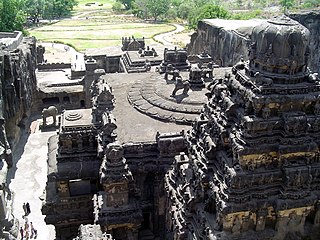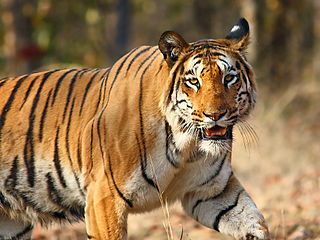
The Satpura Range is a range of hills in central India. The range rises in eastern Gujarat running east through the border of Maharashtra and Madhya Pradesh and ends in Chhattisgarh. The range parallels the Vindhya Range to the north, and these two east–west ranges divide Indian Subcontinent into the Indo-Gangetic plain of northern India and the Deccan Plateau of the south. The Narmada River originates from north-eastern end of Satpura in Amarkantak, and runs in the depression between the Satpura and Vindhya ranges, draining the northern slope of the Satpura range, running west towards the Arabian Sea. The Tapti River originates in the eastern-central part of Satpura, crossing the range in the center and running west at the range's southern slopes before meeting the Arabian Sea at Surat, draining the central and southern slopes of the range. Multai, the place of Tapi river origin is located about 465 kilometer far, south-westerly to Amarkantak, separated across by the hill range. The Godavari River and its tributaries drain the Deccan plateau, which lies south of the range, and the Mahanadi River drains the easternmost portion of the range. The Godavari and Mahanadi rivers flow into the Bay of Bengal. At its eastern end, the Satpura range meets the hills of the Chotanagpur Plateau. The Satpura Range is a horst mountain and is flanked by Narmada Graben in the north and much smaller but parallel Tapi Graben in the south.

Aurangabad district, officially known as Chhatrapati Sambhaji Nagar district, is one of the 36 districts of the state of Maharashtra in western India. It borders the districts of Nashik to the west, Jalgaon to the north, Jalna to the east, and Ahmednagar to the south. The city of Aurangabad houses the district's administrative headquarters. The district has an area of 10,100 km2, of which 37.55% is urban and the rest is rural. Aurangabad District is a major tourism region in Marathwada.

The Meghalaya subtropical forests is an ecoregion of Northeast India. The ecoregion covers an area of 41,700 square kilometers (16,100 sq mi), and despite its name, comprise not only the state of Meghalaya, but also parts of southern Assam, and a tiny bit of Nagaland around Dimapur and adjacent Bangladesh. It also contains many other habitats than subtropical forests, but the montane subtropical forests found in Meghalaya is an important biome, and was once much more widespread in the region, and for these reasons chosen as the most suitable name. The scientific designation is IM0126.

Nagzira Wildlife Sanctuary is Situated in Tirora, Arjuni (Sadak) & Goregaon Tahsils of Gondia District and Sakoli, Bhandara, Lakhni Tahsil of Bhandara district. The closest National Highway is NH-53. Nagzira Wildlife Sanctuary is locked in the arms of nature and adorned with a picturesque landscape, luxuriant vegetation and serves as a living outdoor museum to explore and appreciate nature. This sanctuary has a number of fish, 34 species of mammals, 166 species of birds, 36 species of reptiles and four species of amphibians. The invertebrate fauna includes a number of butterfly and other insect species. Large wild mammals present here include the Bengal tiger, Indian leopard, gaur, sambar, nilgai, chital, wild boar, sloth bear, Indian muntjac, Indian spotted chevrotain and dhole. There is also an Indian elephant named Rupa. Nearly 30,000 tourists visit this sanctuary annually.

Chalisgaon is third largest city and municipal council in Jalgaon district of the Indian state of Maharashtra. It is located in the Khandesh division of the state. and is located about 100 km (62 mi) from Jalgaon and about 330 km (210 mi) from Maharashtra's capital Mumbai.
Kannad is a Taluka and a Municipal Council City in Aurangabad District in the Indian state of Maharashtra. Kannad has located 58 km from Aurangabad. It is located 24 km away from the Ellora Caves and Grishneshwar Temple. It is 45 Km from Daulatabad / Deogiri Fort.
Soegaon or Soyagav is a town and a Taluka in Aurangabad district in the state of Maharashtra, India. It is the headquarter of Soegaon Taluka and located in base of Ajanta hills on Chhatrapati sambhajinagar- Jalgaon Highway in western India. The city is about 120 km from Aurangabad and 60 km from Jalgaon. It is a fast developing city in Aurangabad which has many historical places and scenery like Ajanta Caves, Ghatotkach fort, Vadi fort, Vetalvadi dam, etc.

The state of Karnataka in South India has a rich diversity of flora and fauna. It has a recorded forest area of 38,720 km2 which constitutes 55 of the geographical area of the state. These forests support 25% of the elephant population and 20% of the tiger population of India. Many regions of Karnataka are still unexplored and new species of flora and fauna are still found. The mountains of the Western Ghats in the western region of Karnataka are a biodiversity hotspot. Two sub-clusters of the Western Ghats, Talacauvery and Kudremukh, are on a tentative list of sites that could be designated as World Heritage Sites by UNESCO. The Bandipur and Nagarahole national parks which fall outside these subclusters were included in the Nilgiri biosphere reserve in 1986, a UNESCO designation. In the Biligiriranga Hills the Eastern Ghats meet the Western Ghats. The state bird and state animal of Karnataka are Indian roller and the Indian elephant. The state tree and state flower are sandalwood and lotus. Karnataka is home to 524 tigers.

The Tadoba Andhari Tiger Reserve is a wildlife sanctuary in Chandrapur district of Maharashtra state in India. It is Maharashtra's oldest and largest national park. Created in 1955, the reserve includes the Tadoba National Park and the Andhari Wildlife Sanctuary. The reserve consists of 577.96 square kilometres (223.15 sq mi) of reserved forest and 32.51 square kilometres (12.55 sq mi) of protected forest.

Vedanthangal Bird Sanctuary is a 30-hectare (74-acre) protected area located in the Madurantakam taluk of the Chengalpattu District in the state of Tamil Nadu, India. The sanctuary is about 75 kilometres (47 mi) from Chennai on National Highway 45 ([NH45]). It is easily reachable from Madurantakam and Chengalpattu. More than 40,000 birds, from various parts of the world visit the sanctuary during the migratory season every year. Vedanthangal is home to migratory birds such as pintail, garganey, grey wagtail, blue-winged teal, common sandpiper and the like. It has been designated as a protected Ramsar site since 2022.

The Mhadei Wildlife Sanctuary is a 208.5-km2 (80.5-mi2) protected area in the Indian state of Goa in the Western Ghats of South India. It is located in the North Goa District, Sattari taluka near the town of Valpoi. The sanctuary is an area of high biodiversity, and is being considered to become a Project Tiger tiger reserve because of the presence of Bengal tigers.
The Yawal Wildlife Sanctuary is located in the Yawal Tehsil of the Jalgaon district of Maharashtra, India, at the banks of the Anner and Manjar rivers and at the border of Madhya Pradesh. It is spread over an area of approximately 176 square kilometres (68 sq mi) covered by dense forest.
Banoti waterfall is a remote and desolate location off the village of Banoti in the Soegaon taluka of the Aurangabad district in the Maharashtra state of India. This waterfall is least known in spite of being quite picturesque and enchanting. Access to the place is difficult without involving a long trek from the nearest village of Banoti.
North Maharashtra is a geographical region of Maharashtra State, India. The region is composed of Nashik, Dhule, Nandurbar, and Jalgaon districts. It borders the state of Gujarat to the northwest, Paschim Maharashtra to the south, Konkan to the west, and the Vidarbha and Marathwada regions of Maharashtra to the east.
The Tansa Wildlife Sanctuary is located in Shahapur and Bhiwandi taluka of Thane district and Wada taluka of Palghar district. The sanctuary is spread over an area of 320 square km. This sanctuary is spread around the catchment area of Tansa, Vaitarna and Modak Sagar lakes which are major source of water to the Mumbai, Thane and Bhiwandi cities. There are about 60 villages in the sanctuary area. The forest area is hilly with dense patches of forest.
The AnerDam Wildlife Sanctuary is located in Shirpur talukas of Dhule district, India. The sanctuary is spread over southwestern side of Satpura hill ranges. This sanctuary is spread around the catchment area of Aner river specially above the high flood level around the Aner Dam. This sanctuary has common boundary with Yawal Wildlife Sanctuary in Jalgaon district and forest area of Khargone district in Madhyapradesh.
The Yedshi Ramling Ghat Wildlife Sanctuary is located in Osmanabad district. Yedshi Ramling Sanctuary has headquarters at Yedshi. It is situated 20 km from Osmanabad city and 95 km from Beed city. The Latur-Barshi highway passes through the sanctuary. The sanctuary is situated in Kalamb, Bhansgaon and Wadgaon villages of Osmanabad and Kalamb Tehsil of Osmanabad district. It is situated in the Balaghat mountain range of the Sahyadri. In 1997, the government declared an area of 2237.5 hectares as 'Ramling Ghat' Sanctuary for the protection of various plants, animals and birds. It is also known as hill station as it is high above sea level.

The Ajanta range is a mountain range in the state of Maharashtra in Central India. The range forms northern wall of the Deccan plateau and acts as a watershed between tributaries of the Godavari and Tapi rivers.










